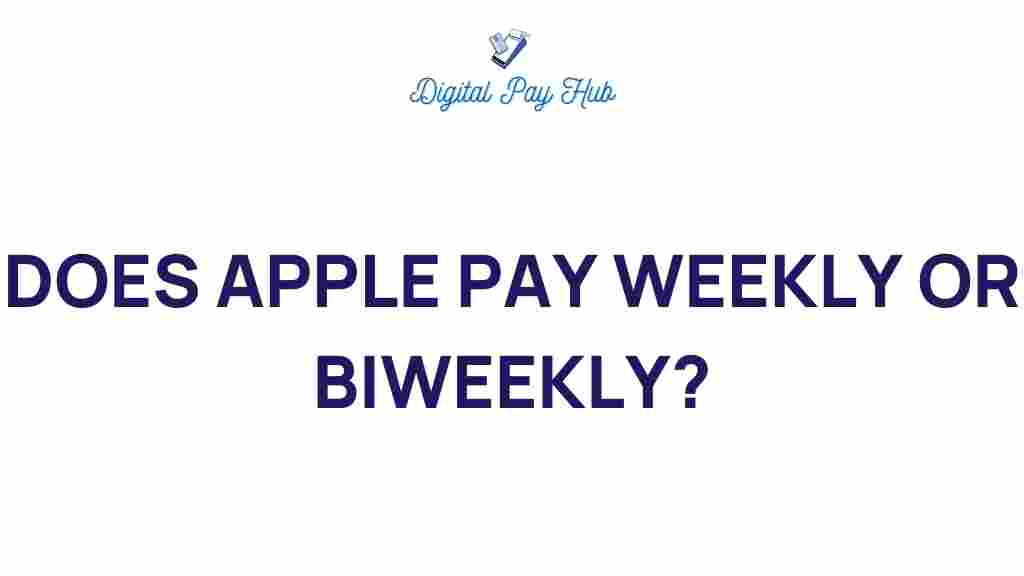Unveiling the Truth: Does Apple Pay Operate Weekly or Biweekly?
In the rapidly evolving world of financial technology, understanding the intricacies of digital wallets like Apple Pay is essential for users seeking convenience and efficiency in their transactions. One of the common queries among users is about the payment schedule associated with Apple Pay. Does it operate weekly or biweekly? This article delves into the details of Apple Pay, exploring its transaction frequency, user experience, and various payment options available.
Understanding Apple Pay
Apple Pay is a digital wallet solution that allows users to make payments in-store, online, and within apps using their Apple devices. It provides a seamless and secure way to transact without needing to carry physical cards. With its increasing popularity, users often wonder about the operational aspects, particularly regarding how often transactions are processed.
Payment Schedule: Weekly or Biweekly?
The payment schedule for Apple Pay does not adhere strictly to either weekly or biweekly timelines. Instead, it operates based on the transaction behavior of the user and the policies of the banks or financial institutions linked to the Apple Pay account. Here’s a breakdown of how it works:
- Immediate Transactions: When you make a purchase using Apple Pay, the transaction is processed immediately. This means that the amount is deducted from your linked bank account or credit card instantly.
- Payment Options: Depending on your selected payment options, you might see different transaction frequencies. For instance, recurring payments set through Apple Pay may occur weekly, biweekly, or monthly, depending on your preferences.
- Bank Policies: Some banks may have policies that affect the visibility of transactions. For example, while a transaction may be processed immediately, it might only show up on your bank statement at a later date, creating confusion about the frequency of transactions.
Transaction Frequency Explained
To better understand how frequently you can use Apple Pay, it’s crucial to consider the types of transactions involved:
- In-Person Transactions: When you use Apple Pay at a store, the transaction occurs in real-time. As soon as you tap your device on the payment terminal, the payment is processed.
- Online Purchases: Similar to in-person transactions, online purchases using Apple Pay are processed immediately upon checkout.
- Recurring Payments: If you set up subscriptions or other recurring payments through Apple Pay, these may follow a weekly or biweekly schedule depending on the service provider’s terms.
User Experience with Apple Pay
The user experience of Apple Pay is designed to be smooth and hassle-free. Here are some key points that contribute to a positive user experience:
- Convenience: With Apple Pay, you can make payments without digging through your wallet. Just tap your device, and you’re done.
- Security: Apple Pay uses encryption and tokenization to protect your financial information, making it safer than carrying cash or cards.
- Integration: Apple Pay integrates seamlessly with other Apple services, enhancing its usability across devices.
How to Set Up and Use Apple Pay
Setting up Apple Pay is straightforward. Follow these steps to get started:
- Open Wallet App: Locate the Wallet app on your Apple device.
- Add Your Card: Tap the “+” sign to add a new card. You can either scan your card or enter the details manually.
- Verify Your Card: Your bank may require verification via SMS or email.
- Start Using: Once your card is added and verified, you can start using Apple Pay in stores, apps, and online.
Troubleshooting Common Issues
While Apple Pay is generally reliable, users may occasionally encounter issues. Here are some troubleshooting tips:
- Transaction Declined: If your transaction is declined, check if your card is supported and ensure you have sufficient funds.
- Device Compatibility: Ensure your device is compatible with Apple Pay. You can check the list of supported devices on the official Apple Pay website.
- Software Updates: Make sure your device is running the latest version of iOS to avoid compatibility issues.
Benefits of Using Apple Pay
Apple Pay offers numerous benefits that enhance the overall payment experience:
- Speed: Transactions are completed quickly, reducing wait times at checkout.
- Privacy: Your actual card numbers are not shared with merchants, providing an extra layer of privacy.
- Rewards and Offers: Some cards offer rewards for using Apple Pay, enhancing the value of your purchases.
Comparing Apple Pay with Other Digital Wallets
While Apple Pay is a leading digital wallet, it’s worth comparing it to other options in the market:
- Google Pay: Similar to Apple Pay, but available on Android devices.
- PayPal: Offers a broader range of online payment options but may not be as integrated into physical retail.
- Samsung Pay: Available on Samsung devices and supports magnetic stripe payments in addition to NFC.
Conclusion
In conclusion, Apple Pay does not operate on a fixed weekly or biweekly payment schedule; rather, it provides flexibility based on user behavior and bank policies. The convenience, security, and user-friendly experience make it a popular choice among digital wallet users. With the ability to set up recurring payments, users can tailor their payment schedules according to their needs. For those looking to enhance their financial technology experience, Apple Pay stands out as a robust option with numerous payment options available.
For more information on optimizing your digital wallet experience, check out our related article here.
This article is in the category Payments and created by DigitalPayHub Team
